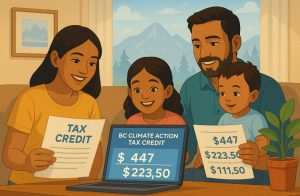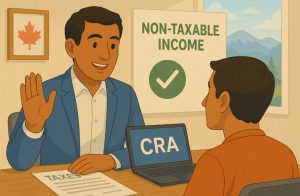Have you ever wondered if you’re entitled to a carbon tax rebate simply by living in British Columbia and filing your taxes? The BC Climate Action Tax Credit was created to ease the financial burden that carbon pricing places on low- to moderate-income residents.
While the program ended in April 2025, millions of British Columbians are still eligible for retroactive payments through the Canada Revenue Agency (CRA). This credit has played a vital role in supporting households as BC worked toward a cleaner economy under the CleanBC initiative.
Whether you missed a past payment, need clarity on how much you might receive, or want to understand the changes brought by the 2025 budget, this guide breaks everything down.
By the end, you’ll understand whether you’re eligible, how to claim your payments, and what steps to take if you missed out. Let’s explore your eligibility and the benefits you might still be able to claim.
What Is the BC Climate Action Tax Credit?

The BC Climate Action Tax Credit (CATC) was a quarterly, non-taxable payment provided by the Government of British Columbia to help low- and moderate-income residents offset the cost of the provincial carbon tax. It aimed to make the province’s climate action policies more affordable and equitable under the CleanBC plan.
However, the CATC program officially ended on April 1, 2025, following the cancellation of the consumer-level carbon tax by the BC government. As a result, the final CATC payment was issued in April 2025, alongside the federal GST/HST credit through the Canada Revenue Agency (CRA).
Even though the program is discontinued, retroactive payments are still available for previous benefit years. Eligible residents can receive these by filing or amending their tax returns for years prior to 2025.
Key features of the former CATC included:
- Non-taxable payments issued quarterly
- Delivered together with the federal GST/HST credit
- No separate application required; eligibility was determined via annual tax filings
- Specifically targeted at low- and moderate-income individuals and families in BC
The termination of the program means residents will no longer receive this credit, but past entitlements can still be claimed if conditions are met.
Who Qualifies for the BC Climate Action Tax Credit?
Eligibility for the BC Climate Action Tax Credit primarily depended on residency, age, family status, and adjusted family net income. If you lived in British Columbia during the tax year and met specific criteria, you could receive the credit, even if you didn’t owe any tax.
To qualify, you needed to meet at least one of the following conditions:
- Be 19 years or older
- Have a spouse or common-law partner
- Be a parent living with your child
Additionally, you had to be a resident of BC on the first day of the quarter and the first day of the previous quarter to receive that quarter’s payment. Special rules applied if you moved in or out of the province.
Income thresholds played a critical role.
For instance:
- Individuals with net income below $61,465 could receive full or partial credit
- Families could qualify with income up to $94,845, depending on the number of children
Even if you missed past years, CRA can assess eligibility when you file backdated returns. So, don’t assume you’re ineligible until you’ve checked all the boxes.
How Much Can You Receive from the BC Climate Action Tax Credit?

The amount you could receive from the BC Climate Action Tax Credit (CATC) in 2025 depended on your family size, income level, and residency status in British Columbia during eligible quarters. The 2025 benefit period marked the final year of the program before its official cancellation.
The 2025 credit structure was designed to support a wider range of households amid growing living costs and environmental changes. For the July 2024 to April 2025 benefit cycle.
The maximum payments were as follows:
- $447 for a single individual
- $223.50 for a spouse or common-law partner
- $223.50 for the first child in a single-parent family
- $111.75 for each additional child under the age of 19
These payments were automatically calculated by the Canada Revenue Agency (CRA) and issued quarterly, typically along with the federal GST/HST credit.
The credit followed a sliding scale based on income:
- Full credit for individuals earning under $61,465
- Full or partial credit for families earning below $94,845
| Recipient Category | Maximum 2025 Payment |
|---|---|
| Single Individual | $447.00 |
| Spouse or Common-Law Partner | $223.50 |
| First Child in Single-Parent Family | $223.50 |
| Each Additional Child (Under 19) | $111.50 |
In early 2025, the BC government cancelled the consumer-level carbon tax, which resulted in the termination of the Climate Action Tax Credit as well. The final CATC payment was issued in April 2025, and no new payments are being made for future years. This change was part of broader policy reforms aimed at revising BC’s approach to carbon pricing.
Although the program has ended, eligible individuals and families can still receive retroactive CATC payments for prior benefit years. If you qualified during past years and haven’t received your credit, filing or updating your past tax returns can trigger a payment from the CRA.
The final phase of the CATC in 2025 closed a long-standing program that had provided meaningful financial support to households while promoting climate responsibility across the province.
When and How Do You Receive the Climate Action Tax Credit?
Even though the CATC program ended in 2025, retroactive payments are still issued through the Canada Revenue Agency (CRA). These credits were historically paid out every quarter in July, October, January, and April.
For a recipient to receive a payment in a particular quarter, they must have been a resident of British Columbia on the first day of the quarter and the first day of the previous quarter. This residency requirement ensured fairness in provincial benefits.
Here’s how payments were typically processed:
- Automatically calculated based on tax return information
- Combined with the GST/HST credit as a single payment
- Delivered via direct deposit or cheque by CRA
To avoid delays during postal strikes or holidays, recipients were encouraged to sign up for CRA direct deposit. Payment status could be tracked via CRA’s “My Account” portal. If you haven’t received your past credit, filing or amending your previous tax return is the key step to unlocking it.
How Do You Apply or Register for the BC Climate Action Tax Credit?

One of the most convenient aspects of the CATC was that no separate application was required. The CRA automatically determined eligibility when you filed your T1 Income Tax and Benefit Return.
To ensure smooth processing:
- File your taxes on time each year
- Include your spouse or partner’s income information, even if it’s zero
- Register your children under the Canada Child Benefit (CCB) to receive child amounts
- Sign up for CRA direct deposit to avoid delays
If you missed filing for previous years, it’s not too late. The CRA can issue retroactive payments once you file backdated tax returns. This is especially relevant for individuals who moved, missed filing due to life changes, or had limited income.
Newcomers to Canada or those filing for the first time should create a CRA account and use the Apply for Child Benefits online service to register their children. Also, ensure your mailing address and banking details are current.
Filing a complete and accurate return is all it takes to activate your credit eligibility.
What Has Changed in the 2025 BC Climate Action Tax Credit?
The most notable change in 2025 was the discontinuation of the BC Climate Action Tax Credit. As announced in the provincial budget, the final payment was issued in April 2025. However, the CRA continues to issue retroactive payments for all prior eligible years.
Here are the main updates from the 2025 budget:
- Final quarter payment for CATC was in April 2025
- Residents may now receive only retroactive credits based on prior filings
- Canada Carbon Rebate (CCR) has replaced the provincial program for ongoing federal carbon tax relief
This shift aligned BC with other provinces using the federal carbon pricing model. While the CATC ended, the provincial government increased support through the BC Family Benefit and enhanced income thresholds to continue helping families.
The cancellation was part of broader fiscal and environmental reforms aimed at simplifying the benefit system while maintaining affordability for BC households.
Is the BC Climate Action Tax Credit Taxable?

The BC Climate Action Tax Credit is fully tax-free. This means the amount you receive is not included as income on your T1 Income Tax and Benefit Return. It will not impact other government benefits or your tax bracket.
Here’s what you need to know:
- You do not report it on your tax return
- It does not reduce other credits or deductions
- It does not affect eligibility for GST/HST or CCB payments
Even though it was provincially funded, the credit appeared on your bank statement as a Government of Canada payment, because the CRA administered it.
This structure made it easier for individuals and families to keep their tax returns simple and avoid confusion during tax season. Ultimately, you get to keep every dollar of the credit without it affecting any other financial assistance or programs.
What If You Didn’t Receive Your Climate Action Credit?
If you didn’t receive your BC Climate Action Tax Credit payment, several issues might be at play. The good news is that in most cases, the CRA allows retroactive payments once the missing information or tax filings are corrected.
First, confirm that you filed your taxes for the relevant year. The credit is automatically applied through your income tax return, so if you haven’t filed, you won’t get it. Second, verify your CRA direct deposit or mailing information to avoid delivery problems.
If you’re unsure why the credit didn’t come through:
- Check your CRA “My Account” payment history
- Contact CRA directly at 1‑800‑387‑1193
- Ensure all dependents are properly registered under CCB
- Check for any missing partner income or T1 return errors
Payments might be delayed during postal disruptions or holidays. Also, if you moved provinces mid-year, you might not have qualified for that quarter. Take action quickly by reviewing your past tax returns and contacting CRA if needed.
Conclusion
The BC Climate Action Tax Credit was a valuable support for many British Columbians, helping to balance the impact of carbon pricing on household expenses. Although the program officially ended in April 2025, you may still qualify for retroactive payments if you lived in BC during prior years and met the eligibility requirements.
Filing your tax returns accurately and on time is essential to claim these funds. With changing climate policies and financial reforms underway, staying informed is the best way to ensure you don’t miss out on what you’re owed.
As BC transitions toward new programs like the Canada Carbon Rebate, you’ll still have access to support systems that prioritise affordability and sustainability. Don’t leave money on the table, check your eligibility, file your return, and stay connected with the CRA for updates.
FAQs
Can non-residents of BC claim the Climate Action Tax Credit?
No, the credit was only available to residents of British Columbia. You had to be a BC resident during the payment period to qualify.
Do students qualify for the BC Climate Action Tax Credit?
Yes, if they were 19 or older or had a spouse or child and filed their tax return. Income eligibility still applied for payment calculation.
Is the credit available if I haven’t filed taxes recently?
No, the credit is only issued after you file your tax return. However, retroactive payments are possible once you submit the missed returns.
Does receiving this credit affect other government benefits?
No, the credit is non-taxable and doesn’t affect other benefits. It’s designed to be supplementary and fully independent.
Can I claim the credit for previous years?
Yes, you can receive retroactive payments by filing tax returns for past years. CRA will automatically assess and issue the credit.
Will the credit increase in the future?
No, the CATC has ended as of April 2025. Future support will come through the federal Canada Carbon Rebate or other provincial programs.
How do I update my banking details for CRA payments?
You can update your banking info through CRA’s My Account online. This ensures you receive future payments without delay.




